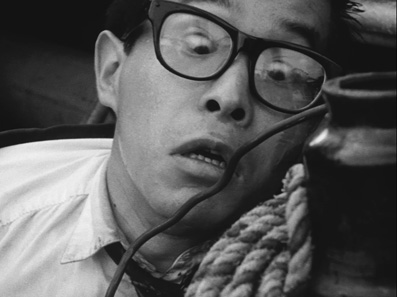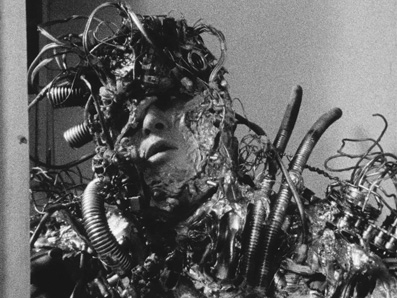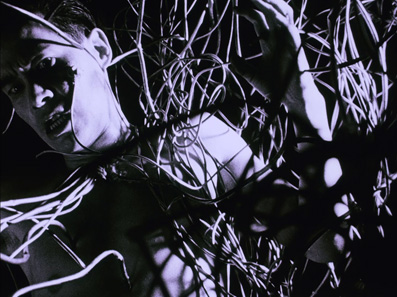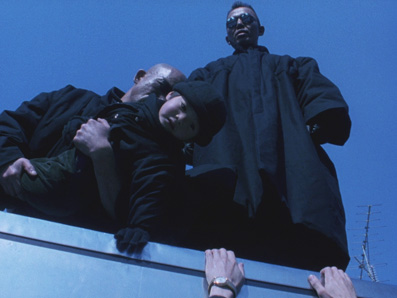| |
Japanese Cyberpunk is a genre of underground film produced in Japan starting in the 1980s. It bears some semblance to the high-tech and scientific Cyberpunk as understood in the West, however differs in its representation of industrial and metallic imagery and an incomprehensible narrative. The genre is primarily defined by the movie Tetsuo: The Iron Man. |
| |
Wikipedia |
For as long as I can remember, I have subscribed to the Nietzschean philosophy that order evolves from chaos, but the fact is it's the chaos that I'm primarily drawn to. It's for this reason, perhaps, that I have always found the punk ethic and its rejection of the values of regular society so appealing. This is particularly true of art. Great art, exciting art, shouldn't bow to formal constraints imposed by convention and taste but kick ruthlessly against them. It should startle and surprise, and with a bit of luck upset and even infuriate the majority of its potential audience. It's with good reason that art critic Robert Hughes titled his definitive exploration of the changing face of modern art The Shock of the New.
But it's a sobering truth of artistic evolution that even revolutionary art eventually becomes part of the established norm. It's for this reason that many innovative young filmmakers make their most exciting work at the dawn of their careers, before their vision is diluted by the demands of studio backers and the lure of commercial success. A select few continue to work within the system without seriously compromising their singular approach, but for all the great movies they go on to make, I still retain a special fondness for those rule-breaking early works. Thus my love of the cinema of David Lynch began and remains loyal to the very specific joys of Eraserhead, and while I greatly admire The Wrestler and adore Requiem for a Dream, Pi remains my favourite Darren Aronofsky film.

And so it is with Tetsuo: The Iron Man, the electrifying first feature shot for cinema by Japanese auteur Tsukamoto Shinya. Like his stateside blood brother David Lynch, Tsukamoto has stuck to his artistic guns and stubbornly refused to start making more conventional and commercially viable films. And let's face it, even when Lynch did give it a go in The Elephant Man and Dune, the results were still unlike anything else around, and the same went for Tsukamoto's studio features Hiruko the Goblin [Yôkai hantâ: Hiruko] and Sôseiji [Gemini]. Tetsuo wasn't Tsukamoto's first feature, but his previous two – the 1986 short Futsu saizu no kaijin [A Phantom of Regular Size] and the 1987 Denchu Kozo no boken [The Adventures Of Electric Rod Boy] – were both shot on 8mm and were likely seen initially only by a small local audience. Tetsuo was his first film made with a cinema release in mind and was the one that put him on the international cult movie map. It also effectively defined the Japanese Cyberpunk sub-genre – that definition above could almost be a sleeve description of this very film.
There is, however, a story nestled within Tetsuo's hyperactive labyrinthine surface. In a Tokyo junk yard, an unnamed Metal Fetishist (played by Tsukamoto) cuts a hole in his leg and forces metal tubing into the wound. A sudden infestation of maggots sends him screaming into the street, where he is struck by a car driven by a Japanese Salaryman (Taguchi Tomorowo), who the following day discovers a small metal shard growing out of his cheek. Unable to remove it, he slaps on a plaster but his body soon begins to mutate and become overtaken by a kind of bio-mechanic cancer. All the while, cocooned in a womb of discarded and misshapen metal, the Fetishist gleefully observes the Salaryman's misfortune, until the time comes to confront him in battle.
Watching Tetsuo for the first time is a bit like having a garage-built shrapnel grenade explode in your brain. If you're looking for reference points, imagine a love child of David Cronenberg, Jan Svankmajer and David Lynch conceived while all three parents were bombed out on acid. It's Cronenberg's body horror to which the film feels the most organically bonded, acknowledged by Tsukamoto himself when he cites Blade Runner and Videodrome as his two key influences. This is particularly evident the latter film's metallic mutation of the human body, where the ridged tentacles that emerge from Max Renn's hand in Videodrome are directly echoed in the tubing that rapes and erupts from the Salaryman's body. Where the two films really part company is in Tsukamoto's avant-garde influenced approach to storytelling and his hyper-energized pacing, with rough-edged stop-motion employed to hurtle the rocket-fuelled opponents through empty Tokyo streets at exhilarating but often dizzying speed and infuse scrap metal with vibrant and destructive organic life.

In the process Tsukamoto takes some real risks, not least in the revelation that the mutating Salaryman's penis has been transformed into a large and rapidly rotating conically shaped drill. It's a sight so bizarre it borders on the comical, at least until it becomes the weapon with which he inadvertently kills his girlfriend, the climax (no pun intended) of a sequence in which sex, mutation and physical destruction become inexorably interlinked. Like Lynch, Tsukamoto pays as much attention to his soundtrack as he does to his consistently striking visuals, which are thematically echoed in Ishakawa Chu's electrifying percussive metal score, while the aggressive scrapes, rattles and crashes of the sound effects transform even the would-be erotic consumption of food into a disturbing and somehow corrupted act.
As the film builds to a kinetic and increasingly abstract climax, a number of seemingly disconnected elements unexpectedly turn out to have had narrative purpose, and it's then that we find out just why the Metal Fetishist appears to have become so fixated on his chosen nemesis, and why that flashback of the Salaryman and his girlfriend having sex in woodland is being presented as video imagery. It's also where the film's underlying fascination with communicable disease and bodily corruption come to a fully focussed thematic head, and the Cronenberg influence switches from Videodrome to Scanners, as former adversaries are biologically united and instilled with the ability to take on and potentially destroy the world.
Tsukamoto has made some great movies since – check out the related reviews in the sidebar for the few we have covered – but for the reasons obliquely outlined in the opening paragraphs, Tetsuo remains my personal favourite. It has the bravery, vision, energy and experimentation of youth, and none of the formalised restraints that film school so often imposes. It's a film whose rough edges are as exciting as its extraordinary visuals, its editing and its soundtrack, and it remains over thirty years after it first appeared the very definition of great outsider cinema.

Three years after the cult success of Tetsuo, Tsukamoto made his third cinema feature, Tetsuo II: Body Hammer, and the excitement at the prospect of a second Tetsuo film was just slightly tempered by concern that after such an auspicious and daring debut, the director might be playing it a little safe. But as secondary titles go, it's hard not to get just a little excited by a term like 'Body Hammer'. What the hell could that mean? I, for one, was itching to know from the moment I first heard it was coming up for release.
The pre-title sequence certainly offers an intriguing hook. As a drunken businessman stumbles through a concrete underpass throwing slurred insults at an off-screen figure, a hand drifts into frame to quietly mimic the sort of gunshot action that most of us have unloaded at someone we dislike at one time or another. Seconds later the salaryman's chest explodes from a series of real bullet wounds that appear to have been fired from the forefinger of wild-eyed young owner of the previously inert hand (played by Tsukamoto).
We're then introduced to our lead character Taniguchi, who as played once again by Taguchi Tomorowo is a virtual carbon copy of the Salaryman from the previous film, but this time has been furnished with a name, a wife and an infant boy named Minori. On a trip to the local mall the three almost collide with two large and imposing goons, who shoot Taniguchi with a weapon that leaves him briefly stunned, then kidnap his son. Taniguchi gives chase is re-united with Minori, but is nearly killed when the abductors try to throw him off a tower block roof.
The encounter has a physiological effect on Taniguchi, who begins working out and experiences a sudden and dramatic increase in strength and stamina. When Minori is abducted a second time and taken to the apartment block rooftop, Taniguchi confronts the kidnapper, but is told that that his son has been dropped into the street below. In his fury Taniguchi begins to bodily mutate and his arm is transformed into biomechanical rifle, with which he attempts to shoot the kidnapper, but inadvertently obliterates Minori instead. Later, the same men return to abduct Taniguchi, who it turns out has been selected as a test subject by an underground group of skin-headed body-builders under the command a scientist who is attempting to transform men into machines.

In some respects, Tetsuo 2: Body Hammer is Tsukamoto's Evil Dead II, a sequel that reworks the original with more technical polish on a larger budget. As the above partial summary suggests, the storyline is more developed than it was in the first film and its characters more emotionally rounded, and there are even a couple of nicely handled narrative twists that I have no intention of revealing here. There is also a thematic shift from the erotic to the militaristic, with a greater focus on the biogenetic weaponry that the skinhead army is being groomed to put to destructive use.
This doesn't mean that traditionalists will be any more comfortable with the film than they were with its predecessor. The pace may be less frenzied and the story more developed and character focussed, but this is still a prime example of confrontational Japanese Cyperpunk cinema. The head-spinning experimentation is still clearly on display, and the move from monochrome to colour allowed Tsukamoto to add strong colour filtration to a heady visual brew that includes strikingly composed angular shots, slow camera drifts, stop-motion animation, aggressive handheld follow shots, matte and effects work and a whole cluster of other, always purposefully employed techniques. And while I may still prefer the more energized and experimental frenzy of the original, this is still thematically and stylistically thrilling cinema. It remains to this day as unique to its extraordinary creator as Videodrome and Eraserhead were to theirs, and in a manner that solidly lays the foundations for Tsukamoto films to come.
Tetsuo: The Iron Man was shot on 16mm on a Canon Scoopic 16 (a camera I've never personally had my hands on) on what looks like two different film stocks, resulting in more aggressive contrast and film grain that is considerably more pronounced in some sequences than others. But considering how rough and ready previous video incarnations of Tetsuo have looked, something we accepted then a by-product of the film's micro budget, the HD transfer here, mastered from the original negative by Tsukamoto himself, is something of a revelation. The quality does vary, but on the finer grain material (the stop-motion shots are a good example) the image quality is seriously impressive, with crisp detail, well balanced contrast and an attractive tonal range. Some edit joins are just visible at the top or bottom of frame, but this is still a major step up from the previous Tartan DVD release. The framing is the original 1.33:1.

Despite its higher production values, Tetsuo II: Body Hammer was also shot on 16mm on the Canon Scoopic 16, though this time with assistance from a Bolex H16 R5, a camera most budding filmmakers of my generation have a lasting affection for. The colour stock employed displays a low level of grain and an attractive colour depth, which has been nicely captured by the transfer here, again mastered by Tsukamoto from the original negative. The use of strong colour filtration is reproduced without issue, as are the brighter colours of Minori's toys and the orange glow of the body building sequences. A good test of the transfer quality are the shots of Taniguchi or his tormentors framed against a clear blue sky, which is vibrantly reproduced and without a trace of compression artefacts. Detail is often excellent (remember we're still talking 16mm here, not 35mm or high-def), and some of the metallic imagery has a genuinely tactile feel. A few dust spots are still evident, as are a couple of splice joins at the very bottom of frame, but for the most part this is another fine transfer of a film I never expected to see looking this good. Once again, the framing is 1.33:1.
The soundtracks for both films have also been restored by Tsukamoto and are reproduced here on DTS-HD Master Audio 2.0 tracks. The results really are impressive, boasting a clarity, range and bass response that exceeds expectations for both films, especially the low budget Tetsuo. Ishigawa Chu's superb industrial scores and the metallic sound effects fare particularly well here.
All of the extra features are in standard definition.
Tetsuo Original Japanese Trailer (3:01)
Cut down to three minutes, shorn of a narrative and not shy about its content, this is possibly an even bigger mindfuck than the film it is selling.
Tetsuo II Original Japanese Trailer (3:19)
A solid enough sell that gives a fair taste of what the film has to offer. The image is rather fuzzy, and the scan lines at the bottom suggest it was hauled off of low band videotape.
UK Trailer (1:56)
A solidly assembled Third Window trailer for this very release.
Interview With Director Tsukamoto Shinya (18:53)
A newly shot interview in which Tsukamoto answers questions set by Third Window and fans of the director's work. The director talks about the formation of the Kaiju Theatre, his early 8mm films, the cyberpunk sensibility, the influence of Blade Runner and Videodrome, the conflicting problem of wanting to reach a larger audience with films that are destined to have only a cult following, the freedom that comes with being self-sufficient, the restoration of the Tetsuo films, and a lot more. Very worthwhile stuff – just ignore the odd grammatical errors on the English subtitles.
Denchu Kozo no Boken / The Adventures of Electric Rod Boy (44:58)
A real treat for Tsukamoto fans, Denchu Kozo no Boken was the 8mm film made by Tsukamoto immediately before Tetsuo. It's the story of a boy with an electric rod growing out of his back who is transported 25 years into the future, where he is trained to do battle with Shinsegumi Vampires, who are working on a machine that will plunge the world into an eternal darkness. Made on a micro-budget by Tsukamoto and members of his Kaiju Theatre, it's very much the work of enthusiastic amateurs learning their craft, but has enough energy, invention and technical and thematic ambition to clearly suggest a major talent in the making, while the production design, makeup and use of stop motion signal where the director was to go next. Pleasingly and unexpectedly, this has also undergone a restoration, but having been shot on 8mm is obviously somewhat softer than the main features.
Background to Denchu Kozo no Boken (5:46)
Shot as part of the interview above, Tsukamoto outlines the plot of Denchu Kozo no Bok and talks about its journey from play to film. He also touches on his fondness for and personal identification with The Ugly Duckling, and the difficulty of compositing effects on 8mm.
You'll also find eight trailers for other Third Window releases, including personal favourites Cold Fish, Sawako Decides and Adrift in Tokyo.
Two of the great Japanese cult movies of the modern age looking and sounding better than they ever have on home video. Packaged as they are with an interview with the director with Tsukamoto and one of his career-shaping 8mm films, this is a superb package that comes highly recommended. In his interview Tsukamoto talks about his intention to produce new digitally restored versions of his other films, and we can only hope that Third Window get their hands on those too.
|